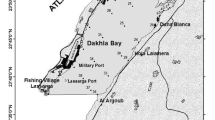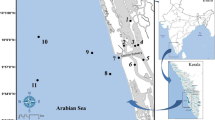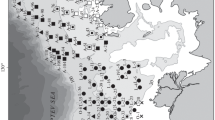Abstract
The structure, diversity and temporal distribution of the infaunal polychaetes associated with Cymodocea nodosa meadows were studied in Tenerife (Canary Islands). The samples were collected monthly throughout a year, to depths of 13–16 m. The sediment was extracted by means of PVC cores, in which four layers were separated (i.e. 0–5 cm, 5–10 cm, 10–20 cm and 20–30 cm). A total of 1,167 polychaete specimens, belonging to 69 taxa were collected, representing one of the most dominant groups in the benthic assemblage throughout the entire year. The most common families were Syllidae, Paraonidae and Spionidae, both in terms of abundance and species richness. The dominant species were Streptosyllis bidentata, Aricidea assimilis and Exogone parahomoseta mediterranea, representing also the only constant species throughout the year. The highest values of species richness, diversity, equitability and abundance of polychaetes occurred in September. The multifactorial analysis of abundances (i.e. cluster analysis and non-metric, multi-dimensional scaling) indicated temporal segregation of the samples from July, August and September (i.e. the warmest months) with respect to those from the rest of the year, due to structural differences in the assemblage. Polychaete species have been found to a depth of up to 30 cm in the sediment. Nevertheless, most of them (89%) occurred in the upper 5 cm of the sediment, with an increase of specimens in deeper layers in February (i.e. due to sporadic episodes of higher hydrodynamics). To compare the vertical distribution of polychaetes, additional core samples were collected in two seagrass meadows (i.e. C. nodosa and Ruppia cirrhosa) at Ebro’s Delta (NW Mediterranean); these were separated into five layers (i.e. 0–5 cm, 5–10 cm, 10–15 cm, 15–20 cm, 20–25 cm). The results obtained for the R. cirrhosa meadow (98% of the polychaetes within the upper 5 cm) agree with those for the Canarian C. nodosa meadow, while the polychaetes reached up to 15 cm depth in the Mediterranean C. nodosa meadow (i.e. ~39% between 0 and 5 cm, ~41% between 5 and 10 cm, ~20% between 10 and 15 cm). Our results indicated that the structural characteristics of the assemblages appeared to be more strongly controlled by the combined characteristics of the sediment (i.e. lack of oxygen, granulometry and degree of compaction) than by the seagrass species building the meadow.





Similar content being viewed by others
References
Afonso-Carrillo J, Gil-Rodríguez MC (1980) Cymodocea nodosa (Ucria) Ascherson (Zannichelliaceae) y las praderas submarinas o sebadales de las Islas Canarias. Vieraea 8:365–376
Allison LE, Moodie CD (1965) Carbonate. In: Black CA (ed) Methods of soil analysis. American Society of Agronomy, Madison, Wisc., pp 1389–1392
Alós C (1988) Anélidos poliquetos de Cabo de Creus (Alt Empordà). Doctoral thesis, Universitat de Barcelona, Barcelona
Besteiro C, Urgorri V, Parapar J (1990) Estratificación vertical y variación temporal de la fauna mesopsámmica de arenas de Amphioxus en la ría de Ferrol (Galicia). Thalassas 8:107–115
Bilyard GR (1987) The value of benthic infauna in marine pollution studies. Mar Pollut Bull 18:581–585
Bloom SA, Simon JL, Hunter VD (1972) Animal–sediment relations and community analysis of a Florida estuary. Mar Biol 15:43–56
Bray JR, Curtis CT (1957) An ordination of the upland forest communities of southern Wisconsin. Ecol Monogr 27:325–349
Brito MC, Núñez J (2002) A new genus and species of Questidae (Annelida: Polychaeta) from the Central Macaronesia Region and a cladistic analysis of the family. Sarsia 87:281–289
Brito MC, Núñez J, San Martín G (2000a) The genus Streptosyllis Webster and Benedict, 1884 (Polychaeta: Syllidae: Eusyllinae) from the Canary Islands, with description of a new species. Bull Mar Sci 67:603–615
Brito MC, Núñez J, San Martín G (2000b) Parapionosyllis macaronesiensis, a new species of Exogoninae (Polychaeta: Syllidae) from the Macaronesian Region. Proc Biol Soc Wash 113:1147–1150
Brito MC, Núñez J, San Martín G (2001) Sílidos (Annelida: Polychaeta) intersticiales asociados a praderas de Cymodocea nodosa de las Islas Canarias. Avicennia 14:85–100
Buchanan JB (1984) Sediment analysis. In: Holme NA, McIntyre AD (eds) Methods for the study of marine benthos. Blackwell, Oxford, pp 41–65
Buchanan JB, Kain JM (1971) Measurement of the physical and chemical environment. In: Holme NA, McIntyre AD (eds) Methods for the study of marine benthos. Blackwell, Oxford, pp 30–52
Buia MC, Russo GF, Mazzella L (1985) Interrelazioni tra Cymodocea nodosa (Ucria) Aschers. e Zostera noltii Hornem in un prato misto superficiale dell’isola d’Ischia. Nova Thalassia 7[Suppl]3:406–408
Camp J, Romero J, Pérez M, Vidal M, Delgado M, Martínez A (1991) Production–consumption budget in an estuarine bay: How anoxia is prevented in a forced system? Oecol Aquat 10:145–152
Clarke KR (1993) Non-parametric multivariate analyses of changes in assemblage structure. Aust J Ecol 18:117–143
Clarke KR, Warwick RM (1994) Change in marine community: an approach to statistical analysis and interpretation. Plymouth Marine Laboratory, Plymouth
Colognola R, Gambi MC, Chessa LA (1984) Polychaetes of Posidonia oceanica (L.) Delile foliar stratum: comparative observation. In: Boudouresque CF, Jeudy de Grissac A, Olivier J (eds) Proceedings of the first international workshop on Posidonia oceanica beds, vol 1. GIS Posidonia, pp 101–108
Cruz E, Vargas JA (1987) Abundancia y distribución vertical de la meiofauna en la playa fangosa de Punta Morales, Golfo de Nicoya, Costa Rica. Rev Biol Trop 35:363–367
Gambi MC, Giangrande A, Martilelli M, Chessa LA (1995) Polychaetes of a Posidonia oceanica bed off Sardinia (Italy): spatial and seasonal distribution and feeding guild analysis. Sci Mar 59:129–141
Gambi MC, Conti G, Bremec CS (1998) Polychaete distribution, diversity and seasonality related to seagrass cover in shallow soft bottoms of the Tyrrhenian Sea (Italy). Sci Mar 62:1–17
Giangrande A, Gambi MC (1986) Polychètes d’une pelouse a Cymodocea nodosa (Ucria) Aschers. du Golfe de Salerno (Mer Tyrrhénienne). Vie Milieu 36:185–190
Howard RK, Edgar GJ, Hutchings PA (1989) Faunal assemblages of seagrass beds. In: Larkum AWD, McComb AJ, Shepherd SA (eds) Biology of seagrasses: a treatise on the biology of seagrasses with special reference to the Australian region. Elsevier, Amsterdam, pp 536–564
Hutchings PA (1982) The fauna of Australian seagrass beds. Proc Linn Soc NSW 106:181–200
Jackson ML (1960) Soil chemical analysis. Prentice Hall, New York
Kikuchi T (1980) Faunal relationships in temperate seagrass beds. In: Phillips RC, McRoy CP (eds) Handbook of seagrass biology: an ecosystem perspective. Garland STPM Press, New York, pp 153–172
Lanera P, Gambi MC (1993) Polychaete distribution in some Cymodocea nodosa meadows around the Island of Ischia (Gulf of Naples Italy). Oebalia 19:89–103
Marr IL, Cresser MS, Gómez Ariza JL (1990) Química analítica del medio ambiente. Servicio de Publicaciones Universidad de Sevilla, Sevilla
Martin D, Ballesteros E, Gili JM, Palacín C (1993) Small-scale structure of infaunal polychaete communities in an estuarine environment: methodological approach. Estuar Coast Shelf Sci 36:47–58
Martin D, Pinedo S, Sardá R (2000) Distribution patterns and trophic structure of soft-bottom polychaete assemblages in a north-western Mediterranean shallow-water Bay. Ophelia 53:1–17
Molinier R, Picard J (1952) Recherches sur les herbiers de phanérogames marines du littoral Méditerranéen français. Ann Inst Oceanogr Paris NS 27:157–234
Palacín C, Martin D, Gili JM (1991) Features of spatial distribution of benthic infauna in a Mediterranean shallow-water bay. Mar Biol 110:315–321
Pielou EC (1969) An introduction to mathematical ecology. Wiley, New York
Reyes J (1993) Estudio de las praderas marinas de Cymodocea nodosa (Cymodoceaceae, Magnoliophyta) y su comunidad de epífitos, en el Médano (Tenerife, Islas Canarias). Doctoral thesis, Universidad de La Laguna, La Laguna, Tenerife, Canary Islands
Rizzo AE, Amaral ACZ (2000) Temporal variation of annelids in the intertidal zone of beaches of the São Sebastião Channel, southern Brazil. J Mar Biol Assoc UK 80:1007–1017
Sanders HL (1969) Benthic marine diversity and the stability-time hypothesis. Brookhaven Symp Biol 22:71–80
Sardá R, Martin D, Pinedo S, Dueso A, Cardell MJ (1995) Seasonal dynamics of shallow-water benthic communities in the western Mediterranean. In: Nicolaidou A (ed) The biology and ecology of shallow coastal waters. Olssen and Olssen, Fredensborg, pp 191–198
Shannon CE, Weaver W (1949) The mathematical theory of communication. Illinois University Press, Urbana
Soler A, Ballesteros M, Turón X (1997) Poliquetos el Estany des Peix (Formentera, Baleares). Aproximación al estudo faunístico y ecológico. Hist Anim 3:9–23
Somaschini A, Gravina MF, Ardizzone GD (1994) Polychete depth distribution in a Posidonia oceanica bed (rhizome and matte strata) and neighbouring soft and hard bottoms. Mar Ecol 15:133–151
Soyer J (1970) Bionomie benthique du plateau continental de la côte catalane française. III. Les peuplements de Copépodes Harpacticoides (Crustacea). Vie Milieu 21:337–511
Terlizzi A, Russo GF (1998) The molluscan taxocoene of different-exposed Cymodocea nodosa beds: year-long structural patterns and sampling methods. Boll Malacol 33:77–82
True-Schlenz R (1965) Données sur les peuplements des sédiments a petites phanérogames marines (Zoostera nana Roth et Cymodocea nodosa Ascherson) comparés a ceux des habitats voisins dépourvus de végétation. Rec Trav Stn Mar Endoume Fac Sci Mars 39:96–125
Walkey A (1947) A critical examination of a rapid method for determining organic carbon in soil. Soil Sci 63:251–263
Whitlatch RB (1977) Seasonal changes in the community structure of the macrobenthos inhabiting the intertidal sand and mud flats of Barnstable Harbor, Massachusetts. Biol Bull (Woods Hole) 152:275–294
Willsie A (1983) Zonation de la macrofaune endogée de la matte d’herbiers de Posidonia oceanica (L.) Delile. Rapp P-V Reun Comm Int Explor Sci Mer Mediterr 28:165–168
Young DK, Young MW (1977) Assemblage structure of the macrobenthos associated with seagrasses of the Indian River Estuary, Florida. In: Coull BC (ed) Ecology of Marine Benthos. Belle W. Baruch Institute for Marine Biology, University of South Carolina Press, Columbia, pp 339–381
Zar JH (1984) Biostatistical analysis. Prentice Hall, Engelwood Cliffs, N.J., USA
Author information
Authors and Affiliations
Corresponding author
Additional information
Communicated by O. Kinne, Oldendorf/Luhe
Rights and permissions
About this article
Cite this article
Brito, M.C., Martin, D. & Núñez, J. Polychaetes associated to a Cymodocea nodosa meadow in the Canary Islands: assemblage structure, temporal variability and vertical distribution compared to other Mediterranean seagrass meadows. Marine Biology 146, 467–481 (2005). https://doi.org/10.1007/s00227-004-1460-1
Received:
Accepted:
Published:
Issue Date:
DOI: https://doi.org/10.1007/s00227-004-1460-1




